
|
| Name: _________________________ | Period: ___________________ |
This test consists of 15 multiple choice questions and 5 short answer questions.
Multiple Choice Questions
1. What does Erikson suggest is in the domain of the inter agency that produces a coherent existence?
(a) The ego.
(b) Ancestors.
(c) Environment.
(d) Biology.
2. How is identity diffusion manifested during the adolescent stages of Erikson's theory of identity development?
(a) Short adolescent moratorium.
(b) Strong identity.
(c) Long adolescent moratorium.
(d) No adolescent moratorium.
3. How does man quantify attributes of himself philosophically and psychologically in terms of Erikson's views of identity development?
(a) Uses the words Us and We.
(b) Uses the words I and self.
(c) Understands the whole society.
(d) Accepts imperfections.
4. What are women isolated by during Erikson's stages of identity development?
(a) Their mothers.
(b) Their fathers.
(c) Their outer productive space.
(d) Their inner productive space.
5. What two components within Erikson's theory are important for youth to base their identities on?
(a) Future and childhood.
(b) Childhood and ideologies.
(c) Ideologies and the future.
(d) Morals and community structure.
6. According to Erikson's theory, what is psychologically different between males and females?
(a) Their ability to express empathy.
(b) Their notions of success.
(c) Their psychological spaces.
(d) Everything.
7. Why does Erikson think the black identity has been confused?
(a) Historical events.
(b) Negativity of black writers.
(c) Many do not fully understand identity.
(d) Lack of study of this population.
8. Throughout the stages of Erikson's theory of identity development, what happens if youth do not take advantage of the wisdom elders have to share?
(a) They can not form their identities.
(b) Nothing.
(c) They may become isolated.
(d) They form distinct identities.
9. Interpreting Freud's theory, what does Erikson feel occurs when the ego resists integrating into new environments?
(a) Identity confusion.
(b) Identity loss.
(c) Identity resistance.
(d) Identity displacement.
10. What type of feelings does Erikson proposed are experienced by those in oppressed groups?
(a) Superiority and self-love.
(b) Interest in other groups.
(c) Indifference and loathing.
(d) Inferiority and self-hate.
11. Who does Erikson suggest black be integrated with?
(a) Only the majority.
(b) Americans with a more exclusive identity.
(c) Americans with a more inclusive identity.
(d) Other minorities.
12. Why does Erikson suggest women are more passive than men?
(a) Environment.
(b) Psychology.
(c) Socialization.
(d) Biology.
13. What does Erikson indicate many psychoanalysts think humans are predisposed to do?
(a) Interact with the environment.
(b) Change the environment.
(c) Be passive actors in their environment.
(d) Accept their environment.
14. Why does Erikson suggest men are resistant to respond to women?
(a) Age-old psychological reasons.
(b) Age-old physical reasons.
(c) It is not proper.
(d) They are frightened.
15. According to Erikson, what must be understood in order to define the ego?
(a) Nature.
(b) Genetics.
(c) Society.
(d) Individual differences.
Short Answer Questions
1. What does Erikson propose reflects the body, personality, and social roles of the person?
2. How does Erikson feel the majority of women react to feminists?
3. What does Erikson suggest occurs in institutionalized settings such as a hospital with regard to identity?
4. What does Erikson suggest might save blacks from having to integrate their identities based on their own decision to do so?
5. What do youth try to balance while going through Erikson's stages of identity development?
|
This section contains 505 words (approx. 2 pages at 300 words per page) |

|




